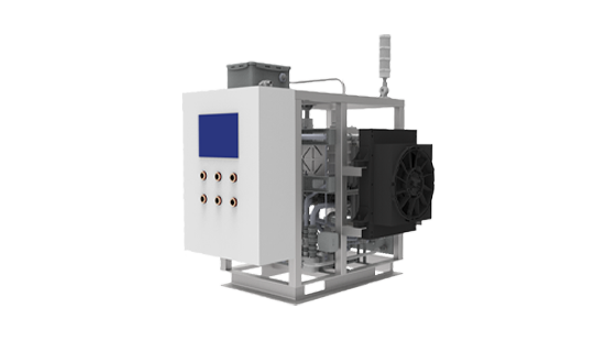
Low voltage power generation stack
The CarNeu system uses a low-voltage low-temperature PEM stacks which developed by the company. Unlike vehicle fuel cell stacks, the stacks use enhanced proton exchange membranes. The load optimization membrane electrode can effectively reduce the degradation speed of the membrane and the loss speed of the catalyst, greatly prolong the service life of the stacks , and meet the requirements of long time power generation. At the same time, the catalyst of the membrane electrode adopts anti-CO poisoning design, which can withstand the impact of 0-10ppm CO poisoning for a long time. This design makes the operation of the stacks very stable and improves the redundancy of the system under the power generation condition.
Small flow hydrogen cycle process
The CarNeu system is integrated with a hydrogen recycling unit specially developed for small flow hydrogen recycling. In this way, the cycle algorithm can be optimized, the utilization rate of hydrogen can be effectively improved (avoiding dangerous straight row or straight row after oxidation), and the power generation efficiency can be improved. The low power consumption design of the circulating device also effectively reduces the impact on the net power generation and efficiency of the system. The highest measured power generation efficiency can reach 53.7%, and the total system efficiency is > 92%.
High level of security design
The CarNeu system is controlled by safety PLC, and multiple complete safety chains are designed. We have integrated multiple hydrogen and smoke detectors both inside and outside the fuel cell, and programmed multiple safety response functions into the program. Once abnormal working conditions such as overtemperature, overpressure, and low pressure occur in the system or abnormal conditions such as leakage and fire occur outside the system, the system will give early warning and automatically stop when necessary to ensure the safety of system operation. In addition, the reactor system adopts low-voltage design, and the operating pressure of the reactor is only 8-14kpa, which reduces the pressure of the pipeline and the reactor, greatly improves the safety of the reactor, and minimizes the risk of hydrogen leakage.
Cold start design
The CarNeu system designed a cold start unit, which can achieve -20℃ fast start. This improves the adaptability of the product to be used in cold areas such as the north.
Modular design
The CarNeu system adopts a modular design concept. The whole system is composed of four modules: fuel cell module, control module, electrical control module and thermal management module. Multiple systems can be easily operated in parallel. The whole system is compact in design, simple and easy to maintain. The system is easy to install, no special requirements on the installation environment, and can be plug and play. In addition, the box of the system adopts a sealed design, and the inside of the box is a state of micro negative pressure. This design can ensure safe and stable operation when installed in a closed environment such as the basement.
Convenient operation
CarNeu system adopts intelligent control design. The system can easily achieve one key start, one key shut down. The whole operation process is very convenient and friendly, and does not require the user to have complex professional theoretical knowledge. The parameters of the system operation can be displayed on the screen, and the user can check the temperature curve, pressure curve, single battery voltage and other parameters of the system at any time. And the system supports the curve power adjustment mode. Users can adjust the power of the fuel cell system according to their individual needs. The system will work in a 24-hour cycle according to the parameter curve set by the user.
|
Item No |
CarNeu-M3 |
|
FC type |
LT-PEM |
|
Fuel |
99.97% Hydrogen( ISO14687 standard) |
|
Fuel Consumption |
≤ 0.204 Kg/h |
|
Power Watts Output |
3KW |
|
Power Quality |
48 VDC |
|
Cold start time |
≤1 min |
|
Hydrogen inlet pressure |
3-5 Bar |
|
Working temperature |
0~45 ℃ |
|
System insulation resistance |
≥500 Ω/V |
|
Weight |
Approx. 200 kg |
|
Dimensions |
730 x 1000 x 1224 mm |